In Italian football, FC Bologna has undergone a remarkable transformation under the astute guidance of Sporting Director Marco Di Vaio. Transitioning from a mid-table club to a formidable force that currently sits in a coveted 4th position, trailing only behind football giants Internazionale, Juventus, and AC Milan, the club’s ascension has caught the attention.
At the helm of this sporting success is not only the tactics of Head Coach Thiago Motta but also the recruitment and strategic vision of Marco Di Vaio. The impact of Di Vaio’s role as Sporting Director has been pivotal, shaping the squad into a competitive force that challenges the traditional hierarchy of Serie A. FC Bologna now finds itself ahead of storied clubs such as Roma, Fiorentina, Lazio, and Napoli, a testament to the effectiveness of their recruitment strategy.
As the team challenges for a spot in the UEFA Champions League, this recruitment analysis delves into the intricate details of Marco Di Vaio’s approach. From identifying key talent to implementing a strategic vision that aligns with the club’s objectives, Di Vaio’s influence extends beyond the transfer market. This analysis seeks to unravel the nuances of FC Bologna’s recruitment strategy under Di Vaio’s guidance with data and statistics.
Director Profile
Marco Di Vaio’s illustrious football career unfolded across Italy, Spain, France, and the MLS, leaving an indelible mark on some of the top clubs in the world. His journey traversed renowned teams such as Lazio, Parma, Hellas Verona, Juventus, and Bologna in Italy, FC Valencia in Spain, AS Monaco in France, and Montreal Impact in the MLS. Di Vaio’s on-field prowess translated into a collection of silverware, with titles including the Italian Serie A, Coppa Italia, Italian Super Cup, and the UEFA Super Cup adorning his accomplished career. Notably, he also donned the blue jersey of the Italian national team.
In a twist to his narrative, July 2012 brought forth a legal challenge, with Di Vaio facing trial for allegedly failing to report match-fixing to the Italian FA despite being aware of it. However, in August 2012, the FIGC’s disciplinary committee acquitted Di Vaio, allowing him to continue his journey unburdened.
Post-retirement from playing, Di Vaio seamlessly transitioned into the administrative side of football. Embarking on his new chapter in early 2015 as the team coordinator for FC Bologna, he rapidly ascended through the ranks. Within four and a half years, he assumed the role of Head of Scouting in 2019, marking his commitment to contributing to the club’s strategic development.
June 2022 saw a significant milestone in Di Vaio’s career as he assumed the role of Sporting Director at FC Bologna. This transition positions him as a key architect in shaping the club’s future trajectory.
Recruitment Analysis
Under the guidance of Sporting Director Marco Di Vaio, FC Bologna’s recruitment strategy this season has been about strategic investment and impressive squad development. The financial metrics, while initially portraying a negative transfer balance of -€32m, unveil a deeper narrative of ambition and foresight.
The club’s €65.50m expenditure on 31 arrivals has been complemented by a notable income of €33.50m through the departure of 35 players. While the balance might seem unfavourable at first glance, it is crucial to delve into the details of these transactions. Di Vaio’s approach focuses not only on immediate financial gains but also on building a squad with long-term potential.
The Purchase Value metric, indicating the initial investment, shows a significant €88.93m difference from the current total market value of the squad of an impressive €208.55m. This discrepancy highlights the club’s acumen in acquiring players whose market values have experienced substantial appreciation, showcasing the potential for future profits.
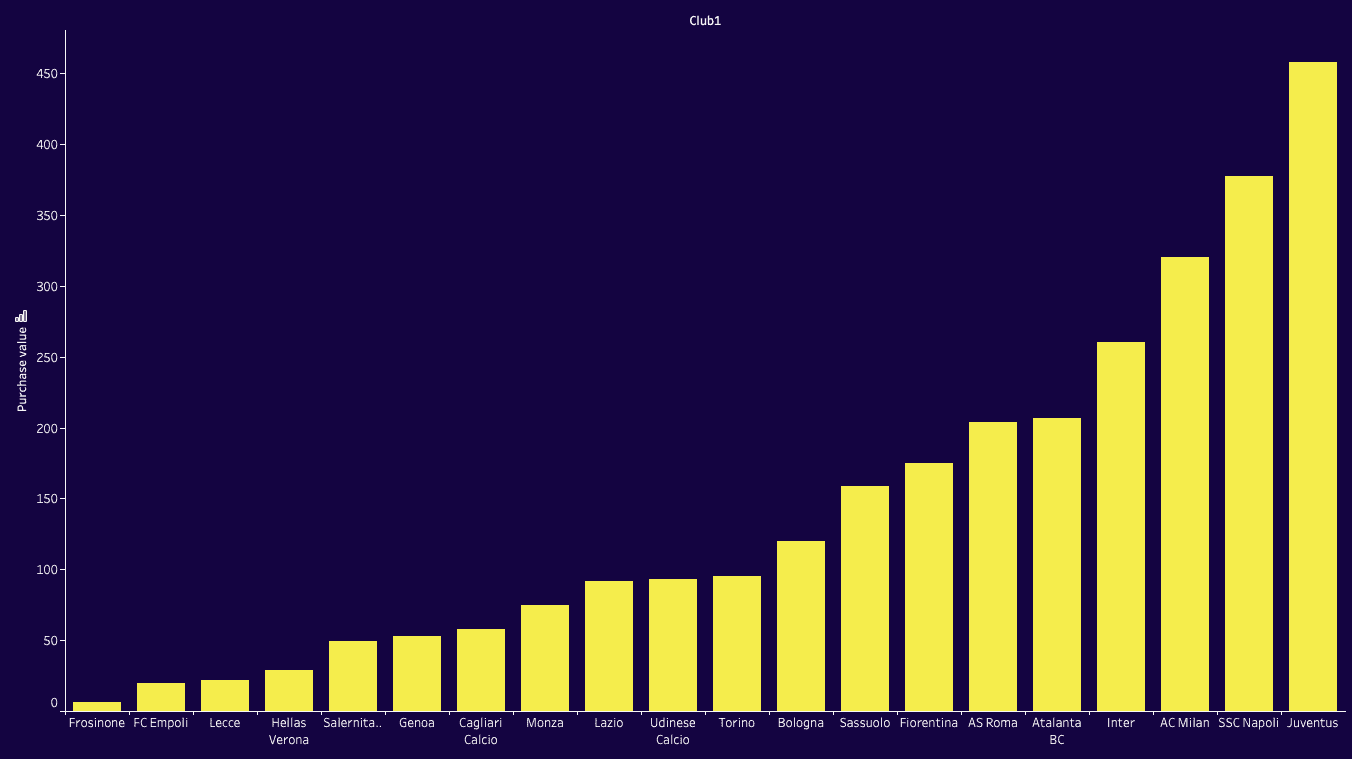
In terms of Transfer Effectivity, FC Bologna’s costs per victory stand at €8.54m, underlining the efficiency with which the club has invested in achieving success on the field. The costs per point and per goal, at €5.72m and €2.92m, respectively, further emphasise the judicious spending that has translated into tangible on-pitch results.
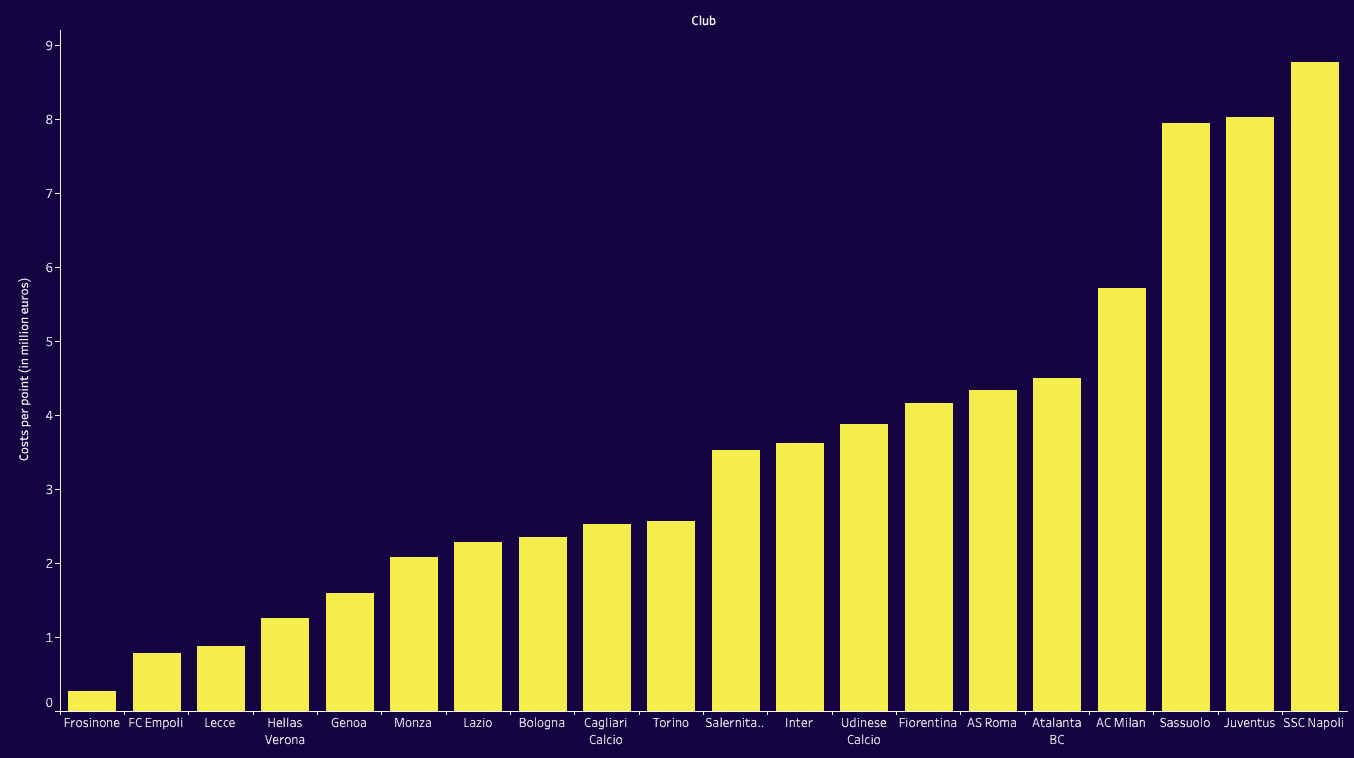
A pivotal aspect of FC Bologna’s success story under Di Vaio is the remarkable Squad Market Value Development. The total market value has seen a tremendous surge, increasing by 58.3% from €131.75m on July 1, 2023, to the current €208.55m as of March 1, 2024. This surge not only reflects the enhanced value of individual players but also underscores the overall growth and potential of the squad.
Under Sporting Director Marco Di Vaio, FC Bologna’s transfer targets have showcased a strategic approach, targeting specific clubs and countries to strengthen their squad. The focus on key markets has been instrumental in the club’s rise in Serie A.
For incoming transfers, the club has strategically engaged with various clubs, with a notable emphasis on nurturing talent from their own youth academy, Bologna Primavera. This commitment to homegrown talent is reflected in the six promotions from their youth ranks to the first team. One of them, Tommaso Corazza, a 19-year-old product of FC Bologna’s youth academy, has already marked his debut for the senior team. Although facing stiff competition for a regular spot in the lineup, Corazza’s notable abilities make him a player to watch. With versatility in playing as a left-back, right-back, and left midfielder, Corazza’s ambipedal skills enhance his adaptability on the field. As he continues to develop, particularly in decision-making, it wouldn’t be surprising to see Corazza earning more minutes as the season progresses.
Looking beyond Italy, FC Bologna has established meaningful connections with clubs like AZ Alkmaar, FC Basel 1893, and TSG 1899 Hoffenheim. These collaborations have not only brought in talent but have also facilitated the exchange of ideas and strategies between clubs. Expanding their global reach, the club has successfully negotiated with clubs from diverse football cultures. From the Argentine Primera División, CA Vélez Sarsfield has been a notable partner. In addition, FC Bologna has secured promising talents from top traditional football clubs like Bayern Munich and Inter Milan. These acquisitions underline the club’s ambition to compete at the highest level and integrate players with experience from successful football cultures.
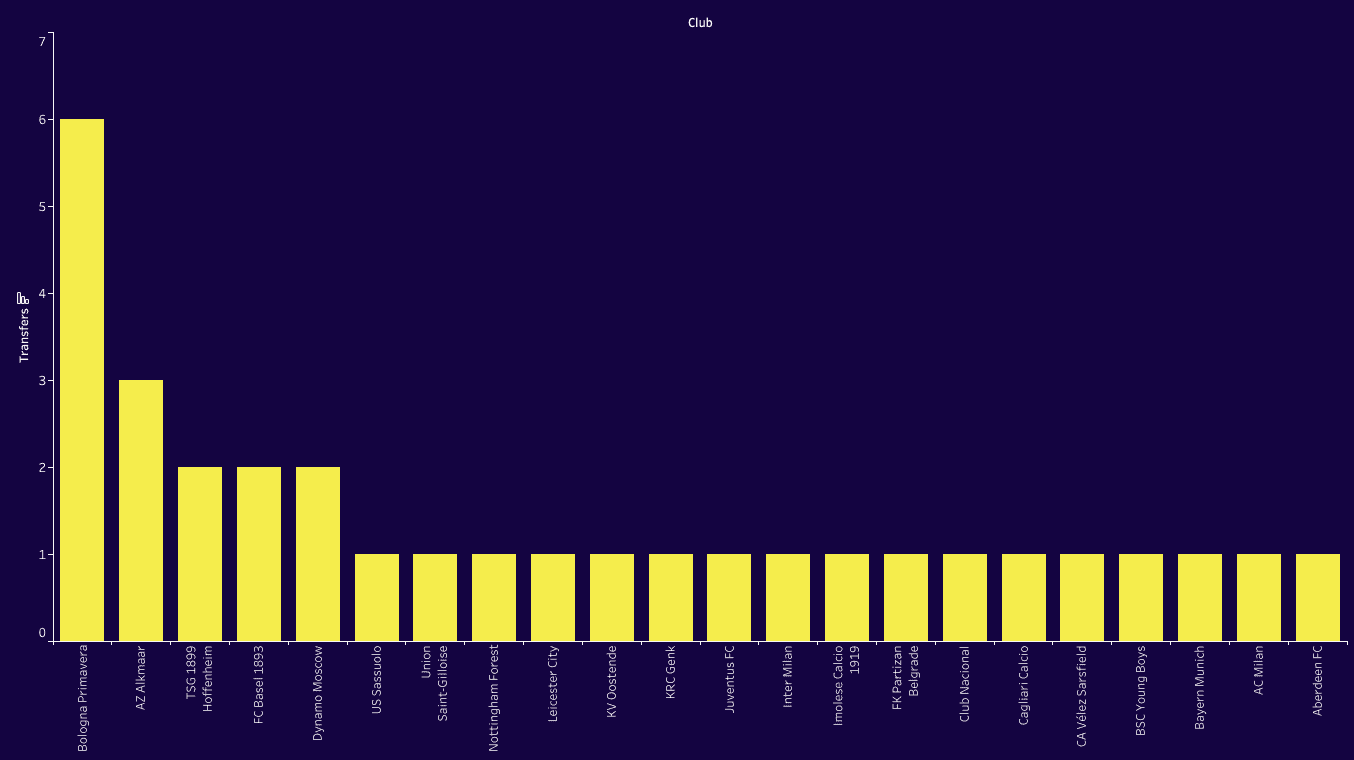
On the outgoing front, FC Bologna has strategically navigated transfer dealings to achieve a positive impact on the financial balance. Notable transfers to clubs like Stade Rennais FC, Brentford FC, and PSV Eindhoven have not only generated revenue but also allowed the club to reinvest strategically in incoming talent.
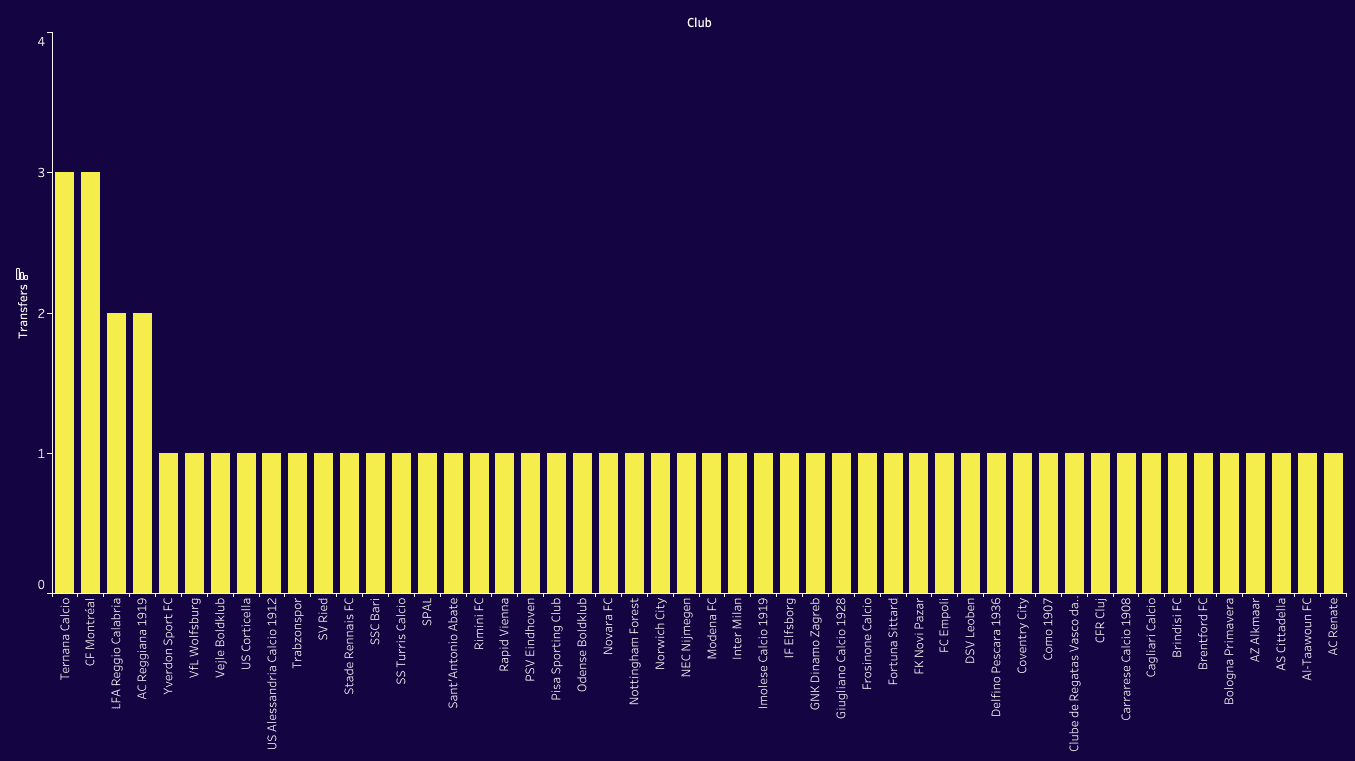
The emphasis on loans, as seen with players heading to clubs like CF Montréal, underscores the commitment to player development, ensuring that talents get valuable playing time and experience even if they are temporarily away from the club. Di Vaio, who played for Montréal himself, uses his connections to the club.
The Last Transfer Period
During the January 2024 transfer window, FC Bologna made strategic moves to bolster their squad, reinforcing key areas and maintaining a solid foundation for the second half of the season. In terms of incoming transfers, Bologna secured three players with a combined expenditure of €17.1m. The acquisitions were strategically focused on key positions, addressing needs in the centre-forward, attacking midfielder, and centre-back positions.
Jens Odgaard, a technically proficient and tall player, arrived on loan from AZ Alkmaar with a €5m option—a deal hailed as a bargain signing. At the same time, primarily a right-winger, Odgaard’s versatility allows him to excel as a striker or second striker. His style of play revolves around exploring pockets of space, contributing creativity, precise ball-striking, and an imposing aerial presence, offering a dynamic dimension to Bologna’s attacking line.
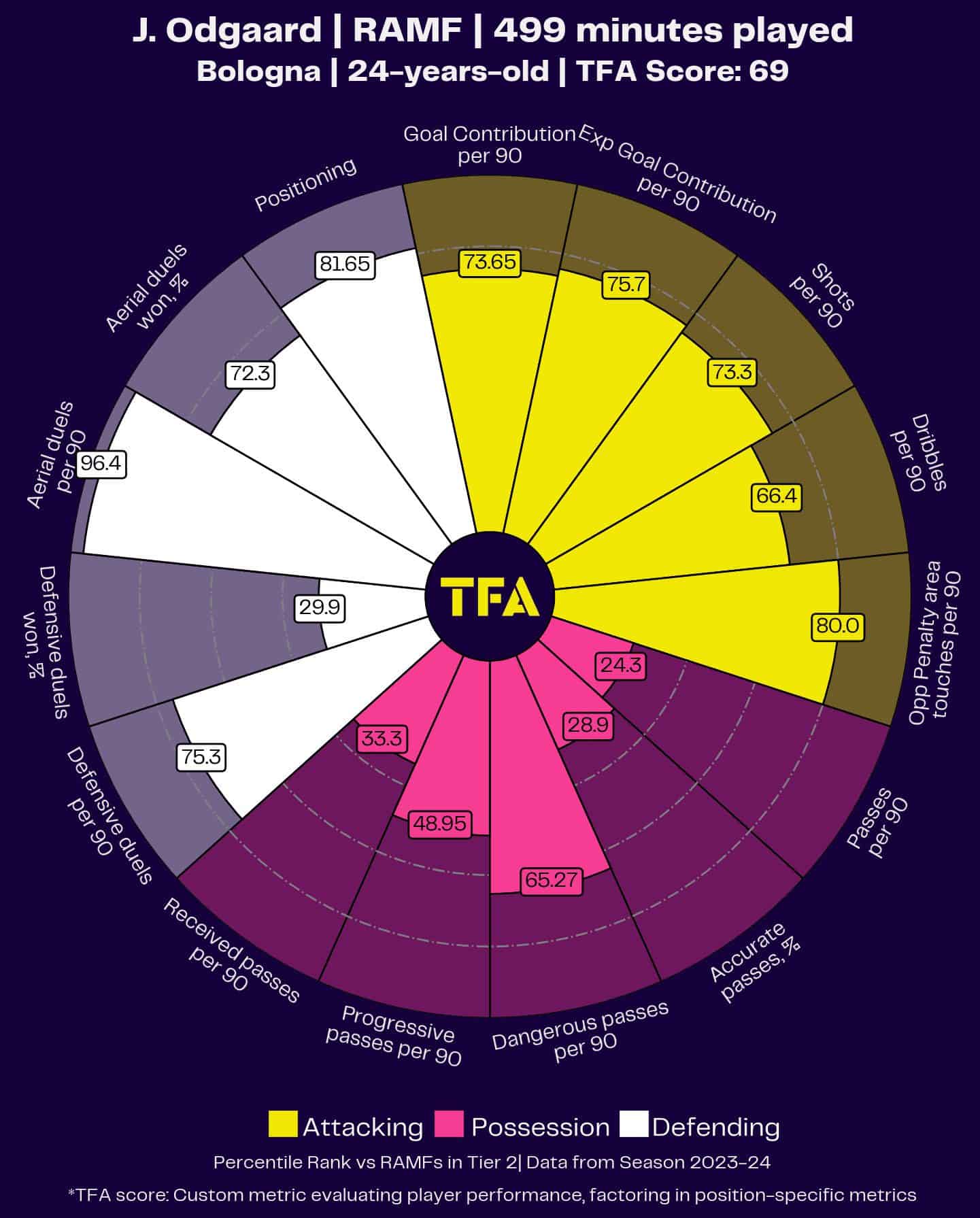
Santiago Castro emerged as the biggest coup of the window, securing the 19-year-old striker from Vélez Sarsfield for €12m. The Argentine prospect boasts a complete forward profile, showcasing a penchant for well-timed runs behind the defence, prowess in aerial duels, and an aggressive yet effective presence. While more focused on goalscoring, Castro’s versatility allows him to contribute on the wings as well, making him a valuable addition to Bologna’s attacking options.
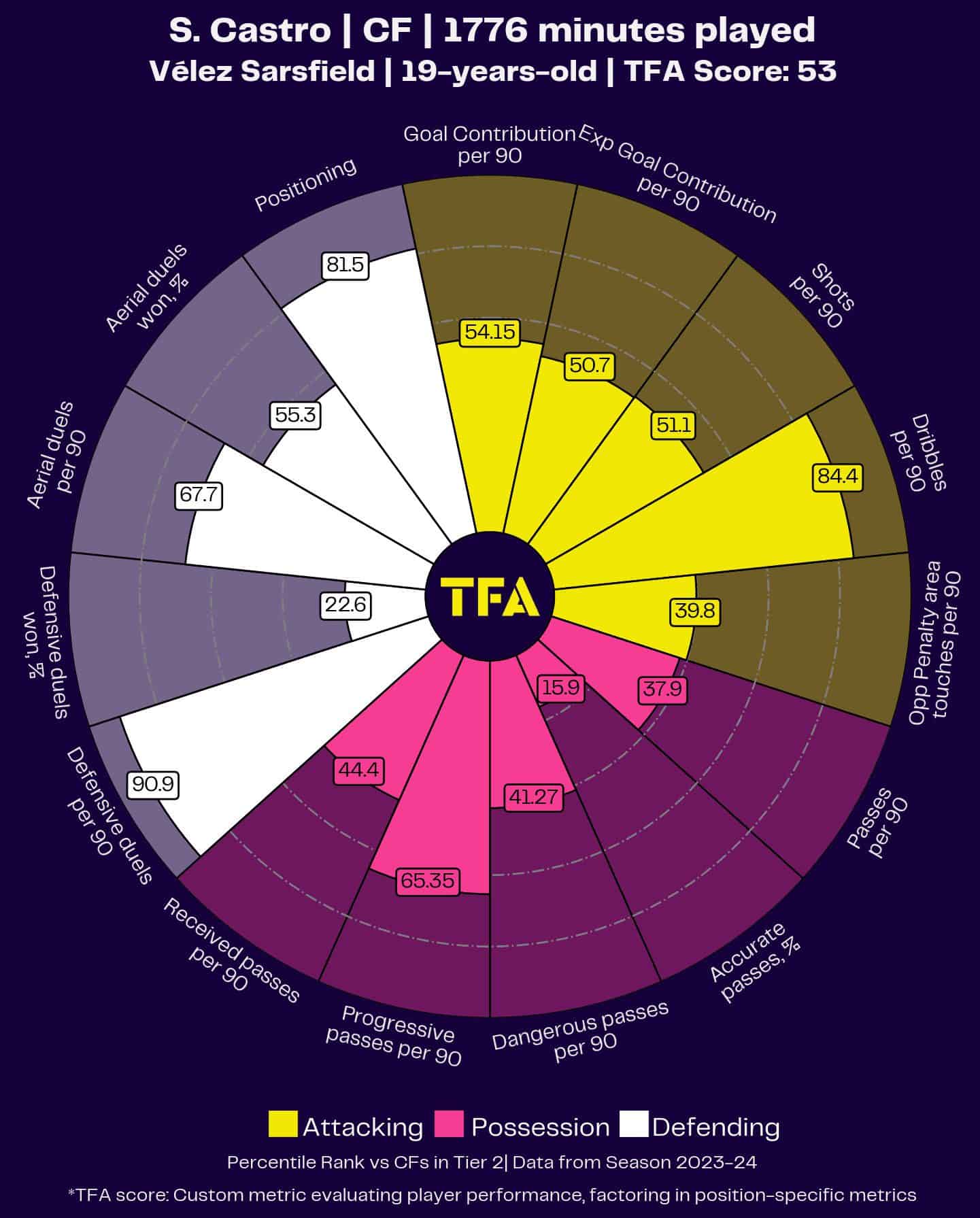
Mihajlo Ilić, a 20-year-old centre-back from FK Partizan Belgrade, joined Bologna for €4.5m. Known for his aggressive defensive style and excellent ball security, Ilić brings progressive passing abilities to the backline. With a knack for line-breaking passes and efficient switches to the wings, his rangy athleticism positions him as a strong fit for Thiago Motta’s tactical approach, promising a formidable presence in Bologna’s defence.
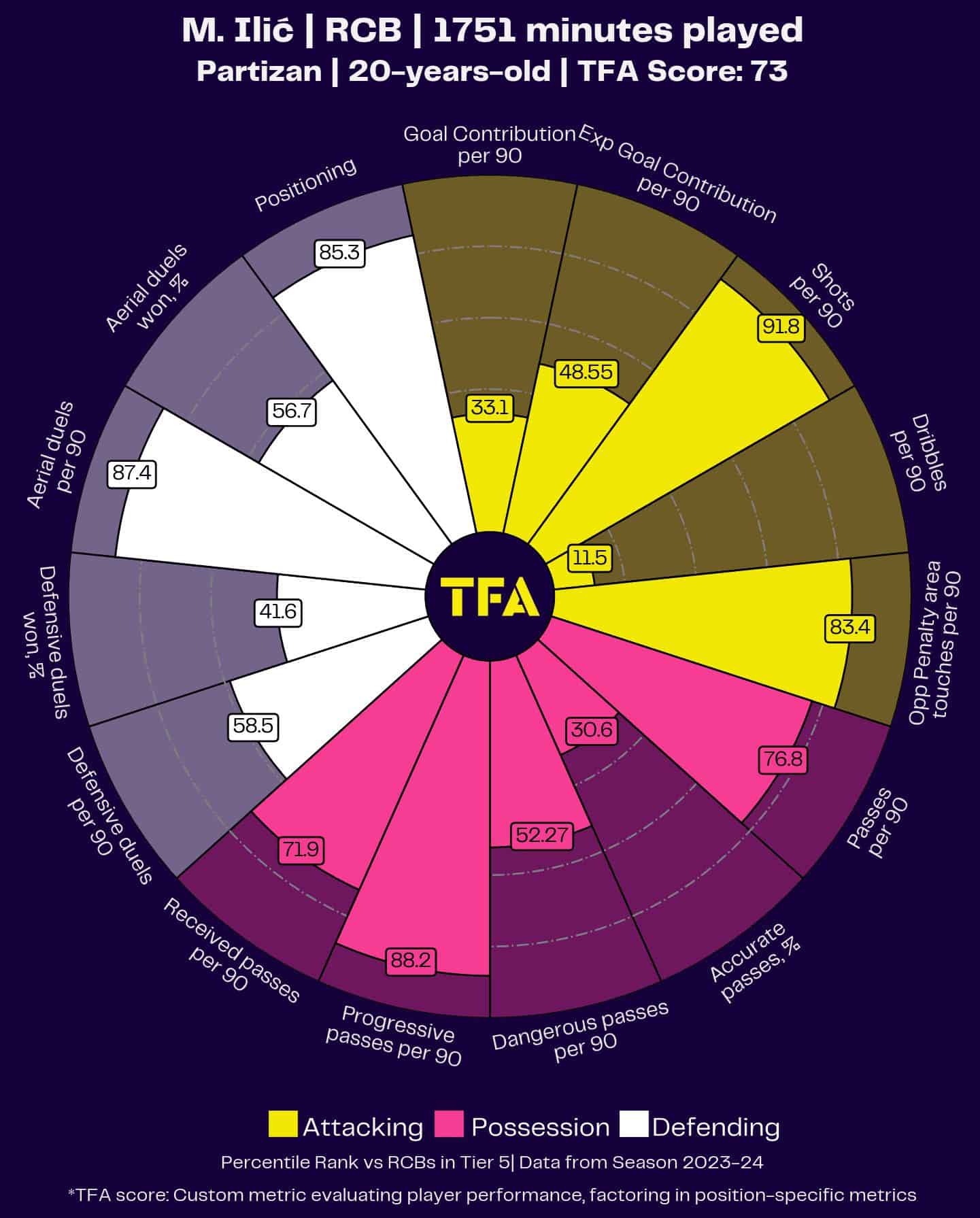
Completing the quartet of incoming transfers is Kazper Karlsson, an 18-year-old midfielder acquired from Halmstads BK for a modest fee of €600,000. Karlsson’s versatility shines as he can proficiently play both central midfield and right midfield positions. Blessed with good spatial awareness, he excels in recycling possession, progressing play, and displaying adeptness at receiving the ball on the half-turn before carrying it forward. Additionally, his strong duelling abilities suggest that Karlsson is a future starter for Bologna, making him a cost-effective and promising addition to the squad.
One notable outgoing transfer was Sydney van Hooijdonk, a 23-year-old striker loaned to Norwich City. Despite struggling to make a significant impact during his limited appearances, this move provides him with a valuable opportunity to rediscover the impressive form he displayed in the previous season with Heerenveen. Other departures included Sebastian Breza (25, GK) to Montréal (free), Joaquín Sosa (22, CB) to Montréal on loan, Kevin Bonifazi (27, CB) to Frosinone on loan, Mattia Pagliuca (21, ST) to Brindisi on loan, and Orji Okwonkwo (26, RW) to Reggiana on loan.
But, FC Bologna’s strategic decisions in the January transfer window not only allowed certain players to explore new opportunities but also ensured the retention of key assets, reinforcing the team’s quest for a top-four finish.
Riccardo Calafiori, a 21-year-old centre-back and left-back, stood out as one of the season’s favourites. Renowned for his excellent anticipation and game understanding, Calafiori showcased remarkable ball responsibility and dynamism. His proficiency in playing one-twos and his natural presence in midfield make him a pivotal asset to the team. With strengths in carrying, aerial duels, anticipation, passing, front-footed defending, and wide-channel defending, Calafiori remains a vital cog in Bologna’s defensive machinery.
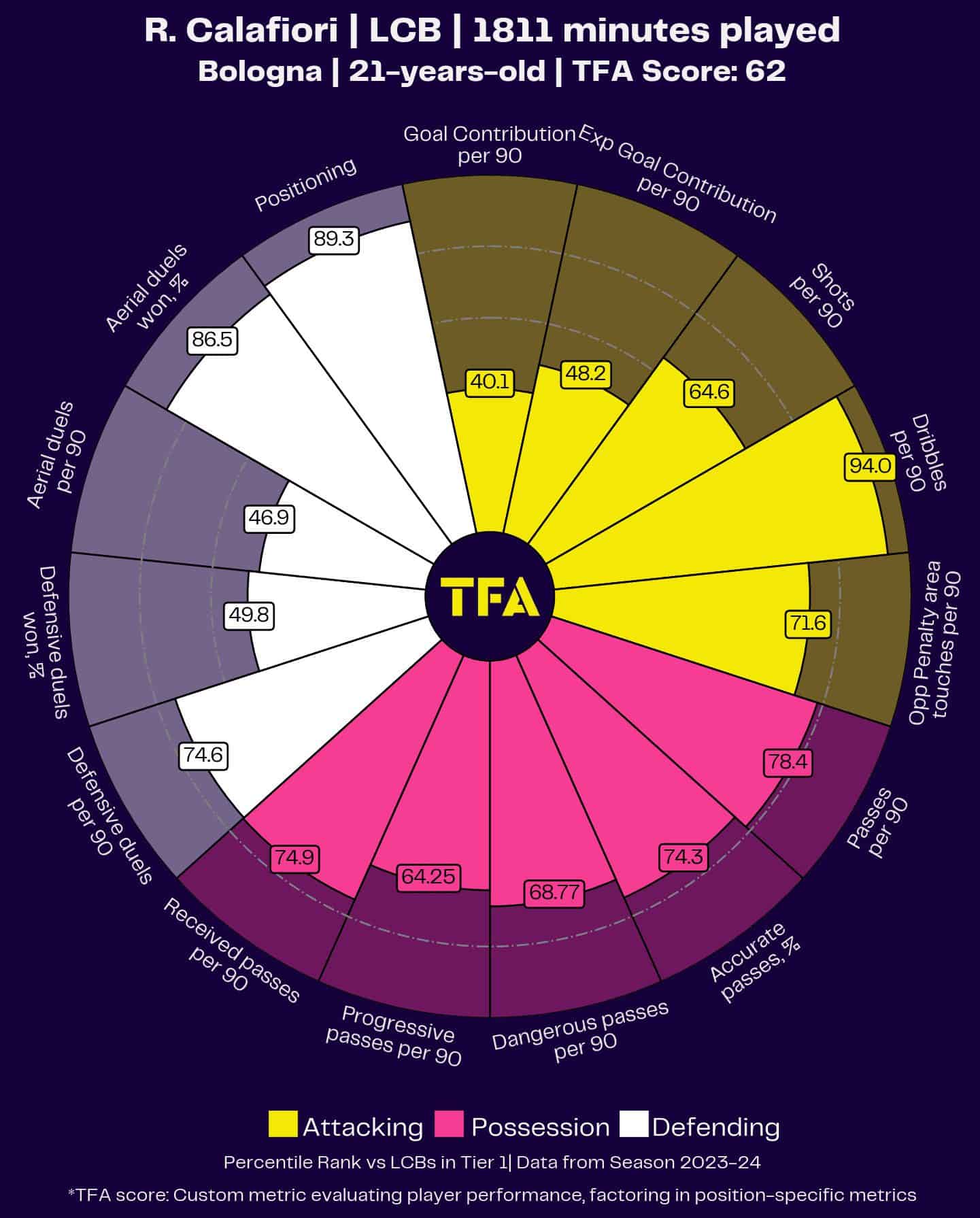
Another crucial player retained by Bologna was Joshua Zirkzee, a 22-year-old striker garnering attention for his exceptional quality on the ball and spatial awareness. Zirkzee’s ability to facilitate play through intelligent link-up play and hold-up play has been a critical component of Bologna’s attacking prowess. Maintaining him was deemed essential for the club’s top-four ambitions. Zirkzee’s impressive season has seen his market value soar from €9m to €30m, a remarkable 233.3% increase.
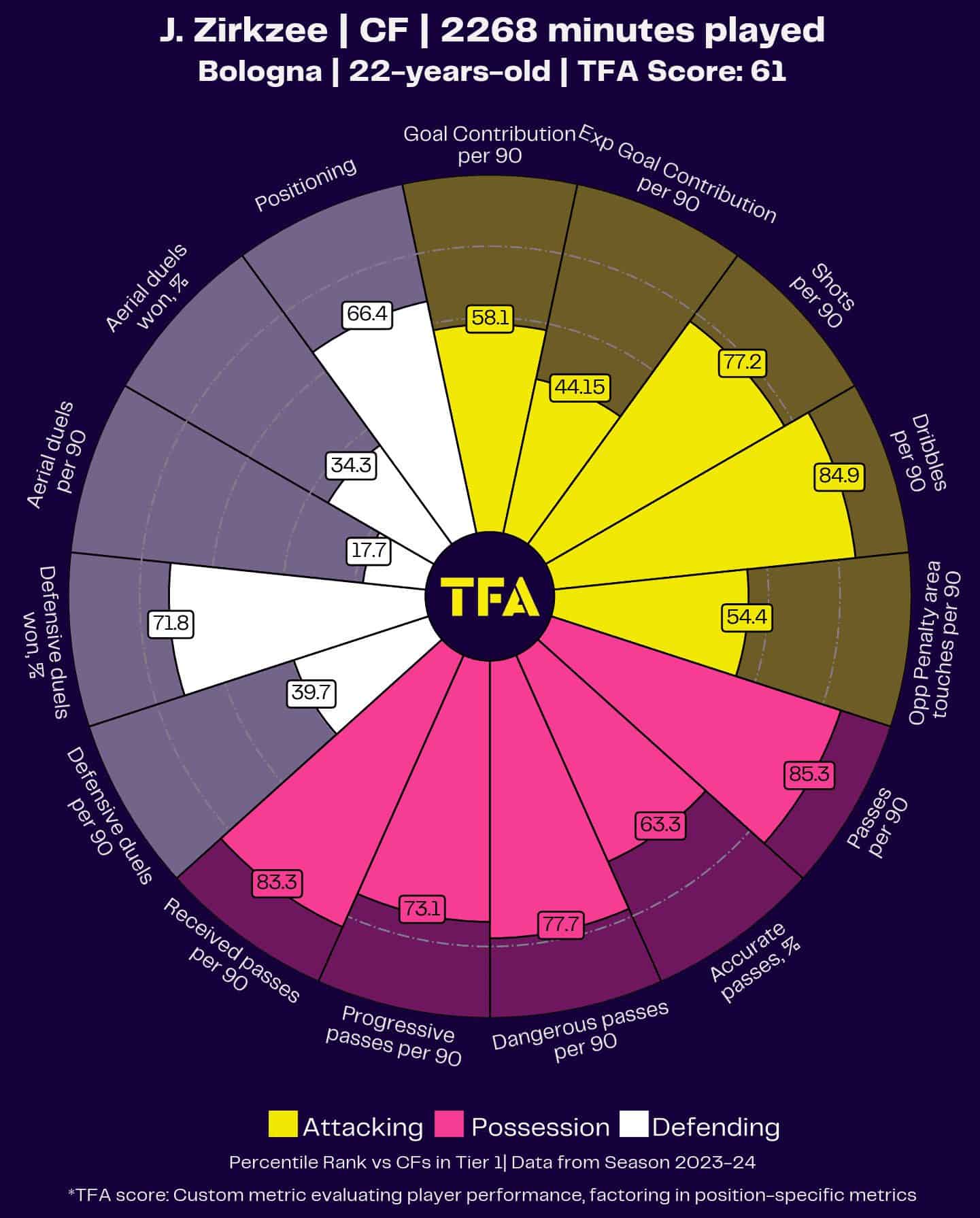
While the net spend stood at -€17.1m, indicating a financial investment in incoming transfers, it’s noteworthy that Bologna managed to retain their key players. This demonstrates a balanced strategy, ensuring that while reinforcing certain positions, the core of the team remains intact. The club’s activity in the transfer window aligns with their reputation for thoughtful recruitment and player development. The focus on key positions suggests a proactive approach to address potential gaps in the squad and elevate the team’s performance in the ongoing season.
Upcoming Transfer Window
As FC Bologna gears up for the upcoming 2024 summer transfer window, the team will face both challenges and opportunities in shaping their squad for the future.
The acquisition of Remo Freuler from Nottingham Forest for €4.5m demonstrates a proactive approach to strengthen the team. The potential return of Joaquin Sosa from his loan spell at Montréal adds depth and options to the squad.
However, there are notable challenges and decisions to be made, with six contracts set to expire in the summer. The potential free agents include Victor Kristiansen, Alexis Saelemaekers, Jens Odgaard, Adama Soumaoro, Charalampos Lykogiannis, and Lorenzo De Silvestri. The club’s ability to exercise buy options for the first three names hinges on their qualification for the UEFA Champions League, which could significantly reduce the number of players leaving as free agents.
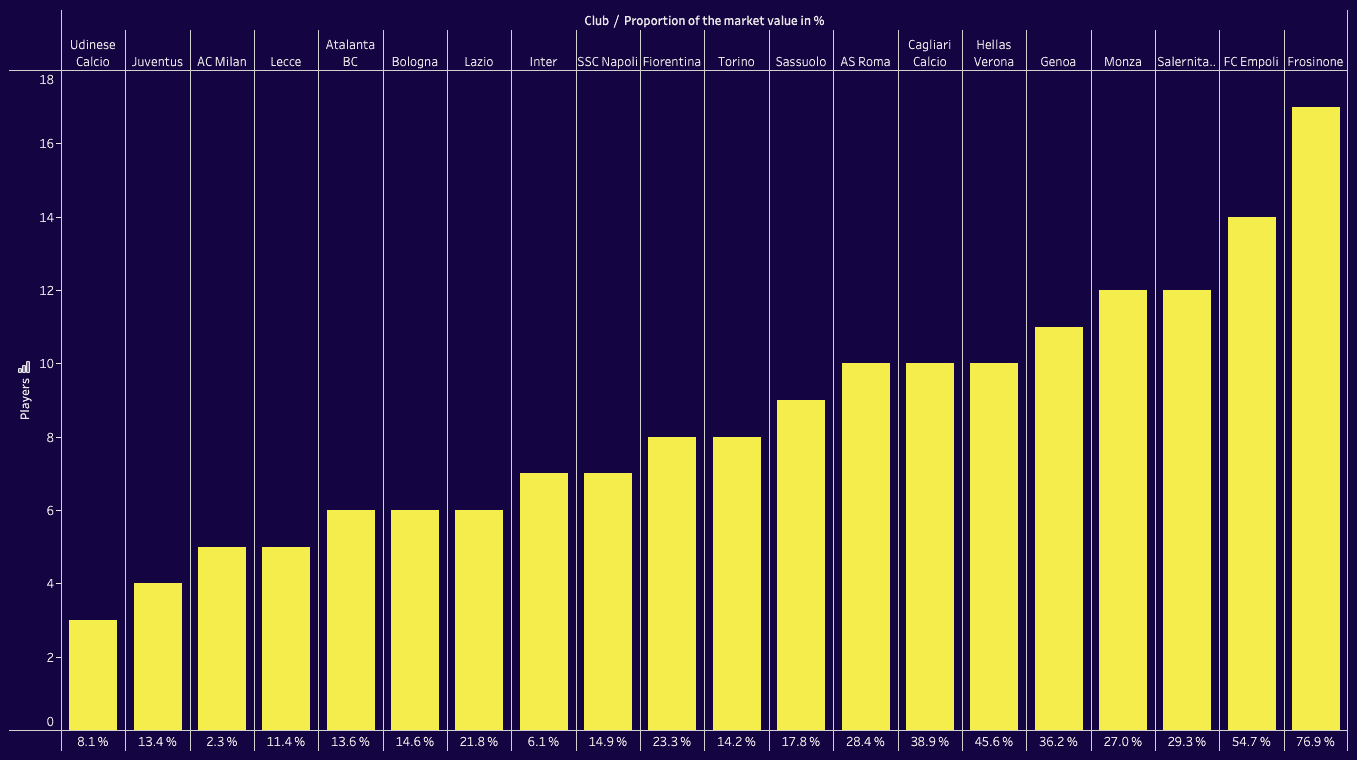
On the departure front, Marko Arnautović is set to leave permanently for a transfer fee of €8m, ending his loan stint from Internazionale. This opens up opportunities for new additions to further bolster the squad’s capabilities.
One noticeable gap in the current squad is the absence of a winger who can provide width and hug the touchline. The ideal addition would be a versatile ambipedal winger capable of playing on both sides, adding a goal threat to the team.
In central midfield, there is a clear need for an upgrade in quality, especially in the double pivot. The emphasis should be on securing a primary ball-winner with physicality, a good turn radius, and strong ball security. Additionally, a deep-lying playmaker with tenacity off the ball, press resistance, and fluidity would enhance the team’s midfield dynamics.
Conclusion
While the negative transfer balance may appear daunting on the surface, FC Bologna’s strategic recruitment and the subsequent positive developments in squad value affirm that the club is playing the long game. The emphasis on acquiring talent with the potential for appreciation, both in terms of performance and market value, positions FC Bologna for sustained success and financial resilience in the future. Under Di Vaio’s guidance, the negative balance emerges as an investment in good profiles for low costs for a brighter and more prosperous footballing future for the club.





Comments